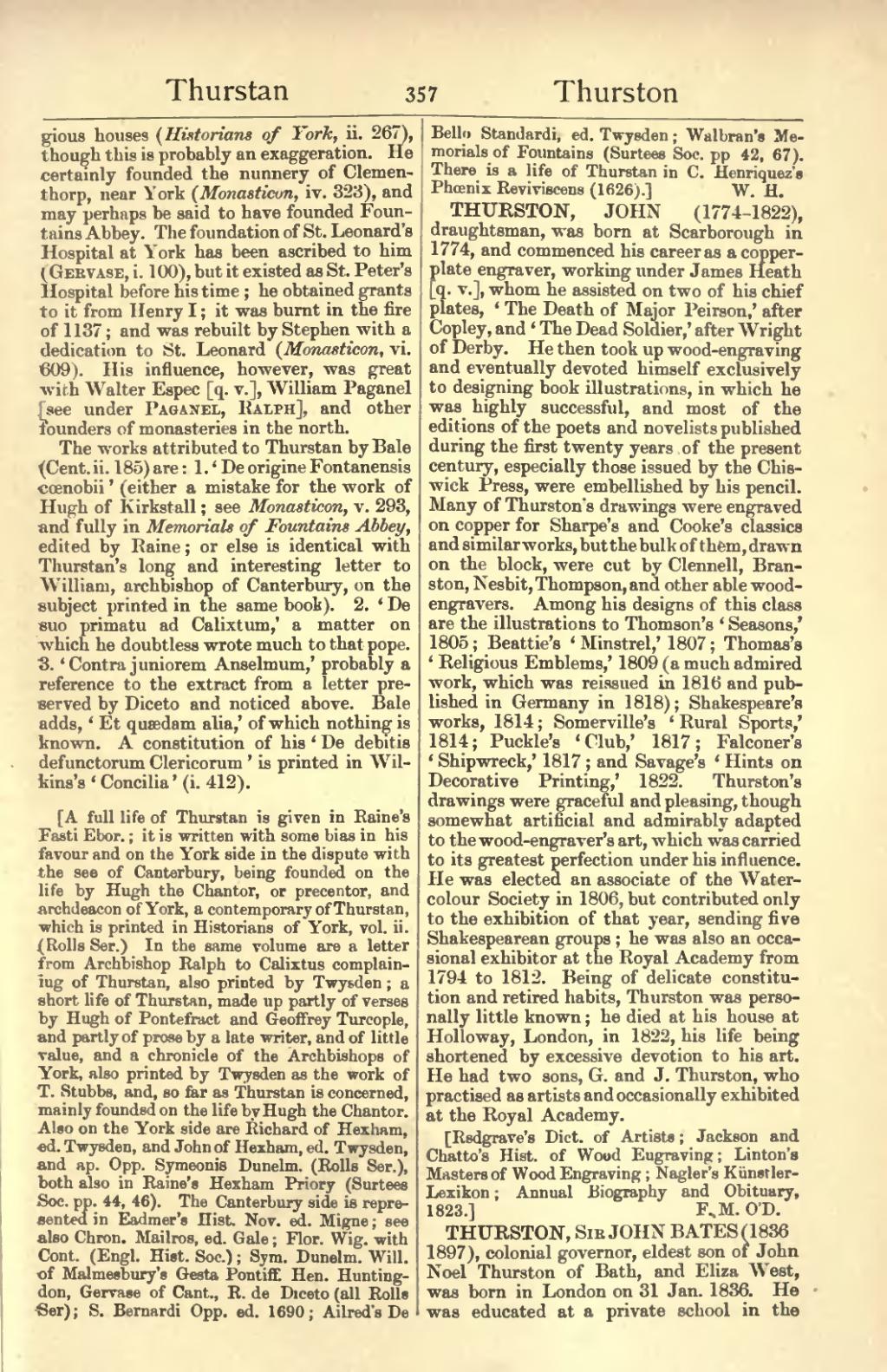gious houses (Historians of York, ii. 267), though this is probably an exaggeration. He certainly founded the nunnery of Clementhorp, near York (Monasticon, iv. 323), and may perhaps be said to have founded Fountains Abbey. The foundation of St. Leonard's Hospital at York has been ascribed to him (Gervase, i. 100), but it existed as St. Peter's Hospital before his time; he obtained grants to it from Henry I; it was burnt in the fire of 1137; and was rebuilt by Stephen with a dedication to St. Leonard (Monasticon, vi. 609). His influence, however, was great with Walter Espec [q. v.], William Paganel [see under Paganel, Ralph], and other founders of monasteries in the north.
The works attributed to Thurstan by Bale (Cent. ii. 185) are: 1. ‘De origine Fontanensis cœnobii’ (either a mistake for the work of Hugh of Kirkstall; see Monasticon, v. 293, and fully in Memorials of Fountains Abbey, edited by Raine; or else is identical with Thurstan's long and interesting letter to William, archbishop of Canterbury, on the subject printed in the same book). 2. ‘De suo primatu ad Calixtum,’ a matter on which he doubtless wrote much to that pope. 3. ‘Contra juniorem Anselmum,’ probably a reference to the extract from a letter preserved by Diceto and noticed above. Bale adds, ‘Et quædam alia,’ of which nothing is known. A constitution of his ‘De debitis defunctorum Clericorum’ is printed in Wilkins's ‘Concilia’ (i. 412).
[A full life of Thurstan is given in Raine's Fasti Ebor.; it is written with some bias in his favour and on the York side in the dispute with the see of Canterbury, being founded on the life by Hugh the Chantor, or precentor, and archdeacon of York, a contemporary of Thurstan, which is printed in Historians of York, vol. ii. (Rolls Ser.) In the same volume are a letter from Archbishop Ralph to Calixtus complaining of Thurstan, also printed by Twysden; a short life of Thurstan, made up partly of verses by Hugh of Pontefract and Geoffrey Turcople, and partly of prose by a late writer, and of little value, and a chronicle of the Archbishops of York, also printed by Twysden as the work of T. Stubbs, and, so far as Thurstan is concerned, mainly founded on the life by Hugh the Chantor. Also on the York side are Richard of Hexham, ed. Twysden, and John of Hexham, ed. Twysden, and ap. Opp. Symeonis Dunelm. (Rolls Ser.), both also in Raine's Hexham Priory (Surtees Soc. pp. 44, 46). The Canterbury side is represented in Eadmer's Hist. Nov. ed. Migne; see also Chron. Mailros, ed. Gale; Flor. Wig. with Cont. (Engl. Hist. Soc.); Sym. Dunelm. Will. of Malmesbury's Gesta Pontiff. Hen. Huntingdon, Gervase of Cant., R. de Diceto (all Rolls Ser); S. Bernardi Opp. ed. 1690; Ailred's De Bello Standardi, ed. Twysden; Walbran's Memorials of Fountains (Surtees Soc. pp 42, 67). There is a life of Thurstan in C. Henriquez's Phœnix Reviviscens (1626).]
THURSTON, JOHN (1774–1822), draughtsman, was born at Scarborough in 1774, and commenced his career as a copperplate engraver, working under James Heath [q. v.], whom he assisted on two of his chief plates, ‘The Death of Major Peirson,’ after Copley, and ‘The Dead Soldier,’ after Wright of Derby. He then took up wood-engraving and eventually devoted himself exclusively to designing book illustrations, in which he was highly successful, and most of the editions of the poets and novelists published during the first twenty years of the present century, especially those issued by the Chiswick Press, were embellished by his pencil. Many of Thurston's drawings were engraved on copper for Sharpe's and Cooke's classics and similar works, but the bulk of them, drawn on the block, were cut by Clennell, Branston, Nesbit, Thompson, and other able wood-engravers. Among his designs of this class are the illustrations to Thomson's ‘Seasons,’ 1805; Beattie's ‘Minstrel,’ 1807; Thomas's ‘Religious Emblems,’ 1809 (a much admired work, which was reissued in 1816 and published in Germany in 1818); Shakespeare's works, 1814; Somerville's ‘Rural Sports,’ 1814; Puckle's ‘Club,’ 1817; Falconer's ‘Shipwreck,’ 1817; and Savage's ‘Hints on Decorative Printing,’ 1822. Thurston's drawings were graceful and pleasing, though somewhat artificial and admirably adapted to the wood-engraver's art, which was carried to its greatest perfection under his influence. He was elected an associate of the Water-colour Society in 1806, but contributed only to the exhibition of that year, sending five Shakespearean groups; he was also an occasional exhibitor at the Royal Academy from 1794 to 1812. Being of delicate constitution and retired habits, Thurston was personally little known; he died at his house at Holloway, London, in 1822, his life being shortened by excessive devotion to his art. He had two sons, G. and J. Thurston, who practised as artists and occasionally exhibited at the Royal Academy.
[Redgrave's Dict. of Artists; Jackson and Chatto's Hist. of Wood Engraving; Linton's Masters of Wood Engraving; Nagler's Künstler-Lexikon; Annual Biography and Obituary, 1823.]
THURSTON, Sir JOHN BATES (1836–1897), colonial governor, eldest son of John Noel Thurston of Bath, and Eliza West, was born in London on 31 Jan. 1836. He was educated at a private school in the
